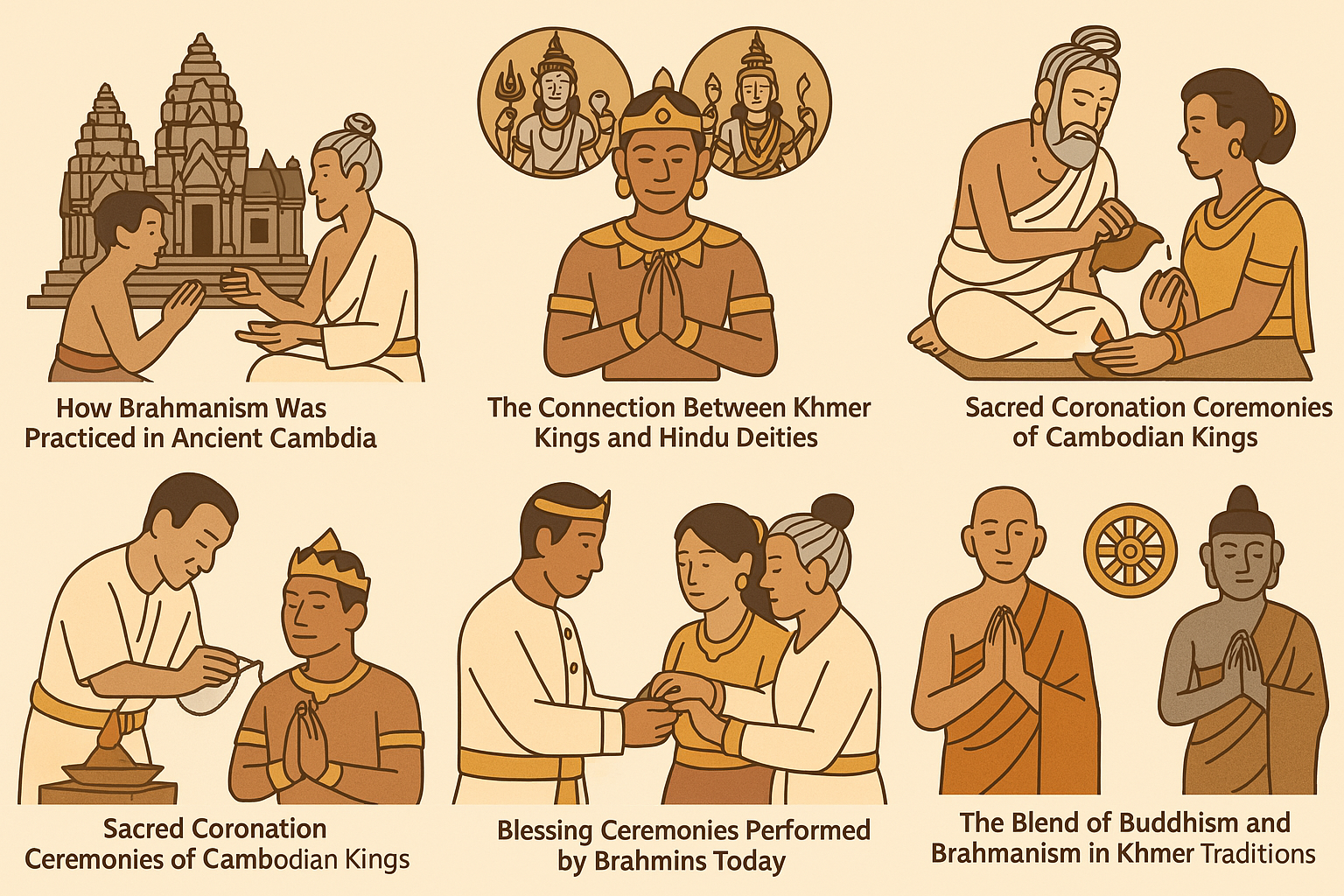Living the Dharma Through Devotion, Ceremony, and Tradition
Buddhism in Cambodia is not only a philosophy but a lived tradition rooted in centuries of sacred ritual. From dawn alms rounds to elaborate ceremonies honoring the dead, Cambodian Theravāda Buddhism is expressed in deeply symbolic, community-centered practices that reflect both ancient Indic traditions and local Khmer beliefs.
These rituals are not passive observances—they are spiritual engines that generate merit, reaffirm cultural identity, and connect the living with the divine and the departed. Whether performed in temples, homes, or village squares, these rituals remain integral to the moral and spiritual fabric of Cambodian life.

Morning Alms-Giving (Dak Bat) to Monks
At the break of dawn, saffron-robed monks silently walk barefoot through villages and city streets, carrying their alms bowls. This practice, known as Dak Bat, is among the most iconic and sacred acts in Cambodian Buddhism.
Key Meanings and Practices:
- Laypeople offer rice, fruit, or simple foods into the monks’ bowls.
- Donors may kneel or bow as a sign of respect and devotion.
- No words are exchanged; the act is meditative and humble.
This ritual embodies reciprocity between the Sangha and the laity. While monks depend on the people for sustenance, laypeople depend on the monks for spiritual merit. Each offering is a symbol of renunciation and generosity, creating karma (merit) for both the giver and the receiver.
Buddhist Chanting and Its Significance
Chanting is the spiritual heartbeat of Cambodian Buddhist rituals. Known in Pali as paritta (protective verses), the chants are often recited in ancient Pali language, invoking blessings, wisdom, and protection.
Purposes of Chanting:
- Invoking the Triple Gem (Buddha, Dharma, Sangha).
- Blessing ceremonies for homes, businesses, weddings, and new ventures.
- Funerary chants to guide the departed soul and console the grieving.
- Used during meditation sessions for focus and reflection.
Chanting is seen as a vibrational offering, where sound itself is sacred. The rhythmic, melodic repetition of verses is said to cleanse the mind, calm emotions, and purify the environment.
Water Blessings and Purification Ceremonies
Water holds profound spiritual meaning in Cambodian rituals, symbolizing cleansing, rebirth, and spiritual refreshment. One of the most beloved ceremonies involves a monk sprinkling holy water (Tep Vot) over devotees during blessings.
Ritual Elements:
- Sacred water is infused with mantras and flower petals.
- Monks sprinkle the water using a bundle of palm leaves or pour it gently over the head.
- Practiced during New Year, ordinations, or before long journeys.
Water blessings are also performed to ward off illness, misfortune, or spiritual pollution. For many Cambodians, it is a form of healing, protection, and renewal.
The Importance of the Buddhist Lent (Vassa)
Known in Khmer as Chol Vossa, Buddhist Lent is a three-month period (usually from July to October) during the rainy season when monks retreat into their monasteries for study, meditation, and strict discipline.
Lay Participation:
- Devotees bring offerings of candles, robes, and food.
- Many undertake temporary vows, such as abstaining from alcohol or meat.
- Families gather for sermons, chanting, and merit-making.
Historically, this tradition began to prevent monks from traveling during the planting season to avoid trampling young crops. Spiritually, it is a time for intensive spiritual cultivation, much like Lent in Christianity or Ramadan in Islam.
Kathina: The Robe-Offering Ceremony for Monks
Kathina is one of the most important communal merit-making festivals in the Cambodian Buddhist calendar. It occurs at the end of Vassa, as laypeople express gratitude to the monastic community by offering new robes and other necessities.
Key Features:
- Villagers process joyfully to the temple, often with music and decorated offerings.
- Special robes (Kathina cloth) are presented to monks, symbolizing renewal.
- It’s a time of communal generosity and harmony, strengthening ties between the monastery and the people.
Offering robes is considered a great meritorious act because it supports the monastic path and honors their spiritual discipline during the retreat.
Traditional Ordination Ceremonies in Cambodia
Ordination (Pabbajjā) is one of the most sacred milestones in Cambodian Buddhist life. Whether temporary or lifelong, entering the monkhood is a respected act that brings honor to one’s family and community.
The Ceremony Includes:
- Hair shaving as a sign of renunciation.
- Wearing the triple robe (Tricīvara).
- Recitation of the Ten Precepts (for novices) or 227 Precepts (for bhikkhus).
- Ceremonial chanting and blessings by senior monks.
Young men are often expected to ordain at least once in their life—even if only briefly—before marriage. This rite marks a period of spiritual purification, discipline, and inner growth.
Funeral Rites and Buddhist Beliefs About the Afterlife
In Cambodian Buddhism, death is a passage, not an end. Funerals are complex, sacred ceremonies designed to assist the soul on its journey toward rebirth, often taking place over several days.
Typical Funeral Rituals:
- Monks chant Pali verses to transfer merit to the deceased.
- The body is often cremated, with ashes placed in a stupa or buried at a pagoda.
- Seven-day, 50-day, and 100-day memorial ceremonies are common.
- Families may offer food, robes, or money to monks in the name of the deceased.
Underlying all these rituals is the belief in rebirth, karma, and spiritual continuity. Funerals are as much for the living—who seek closure and peace—as for the dead, who are gently guided through the bardo (intermediate state) by prayers and merit.
Conclusion: Living the Dharma through Ritual
Sacred rituals in Cambodian Buddhism are more than symbolic—they are acts of devotion, discipline, and transformation. Each gesture, chant, and offering is infused with meaning, passed from one generation to the next.
These rituals bring structure to the spiritual lives of Cambodians, weaving Buddhist philosophy into the everyday rhythm of birth, growth, death, and rebirth. In a world of change, they offer continuity. In a time of doubt, they offer clarity. And in moments of joy or grief, they offer meaning and mindfulness.





